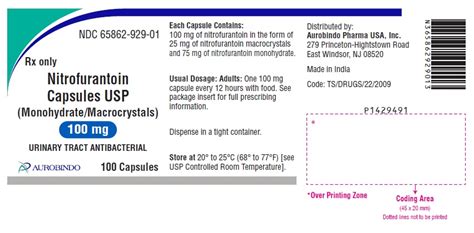Intro
Discover key facts about Nitrofurantoin mono, a urinary tract infection treatment, including its mechanism, side effects, and interactions, to understand its role in antibacterial therapy and manage UTI symptoms effectively.
The importance of antibiotics in modern medicine cannot be overstated. These medications have revolutionized the way we treat bacterial infections, saving countless lives and improving the quality of life for millions of people around the world. Among the many types of antibiotics available, nitrofurantoin, particularly in its monohydrate form known as nitrofurantoin mono, stands out for its efficacy in treating specific types of bacterial infections. Understanding nitrofurantoin mono is crucial for both medical professionals and patients alike, as it can provide valuable insights into how this antibiotic works, its benefits, and its potential side effects.
Nitrofurantoin mono is primarily used to treat urinary tract infections (UTIs), which are among the most common bacterial infections. UTIs can range from mild to severe and can affect any part of the urinary system, including the kidneys, ureters, bladder, and urethra. The prevalence of UTIs and the potential for them to become serious if left untreated underscore the importance of effective antibiotics like nitrofurantoin mono. Furthermore, the rise of antibiotic resistance has made the development and use of targeted antibiotics crucial in the fight against bacterial infections.
The mechanism of action of nitrofurantoin mono, its pharmacokinetics, and its efficacy in treating UTIs are just a few aspects that highlight its significance in the field of medicine. Moreover, understanding the potential side effects, drug interactions, and contraindications of nitrofurantoin mono is essential for safe and effective treatment. This knowledge not only helps in the proper management of UTIs but also contributes to the broader discussion on antibiotic stewardship and the responsible use of antibiotics to combat resistance.
Introduction to Nitrofurantoin Mono

Benefits of Nitrofurantoin Mono
The benefits of nitrofurantoin mono include its high efficacy in treating UTIs, particularly those caused by E. coli, which is one of the most common pathogens responsible for these infections. Additionally, nitrofurantoin mono has a relatively low risk of inducing antibiotic resistance, which is a significant concern with many other antibiotics. Its targeted action also means that it has fewer effects on the body's normal flora compared to broad-spectrum antibiotics, potentially reducing the risk of side effects such as diarrhea or yeast infections.Working Mechanism of Nitrofurantoin Mono

Steps for Effective Use
For the effective use of nitrofurantoin mono, patients should follow the prescribed dosage and treatment duration closely. It's also important to stay hydrated by drinking plenty of water to help the antibiotic work more effectively in the urinary tract. Additionally, completing the full course of treatment as directed by the healthcare provider is crucial, even if symptoms improve before finishing the medication, to ensure that the infection is completely cleared and to reduce the risk of resistance development.Side Effects and Precautions

Drug Interactions
Understanding potential drug interactions with nitrofurantoin mono is also crucial for safe use. For example, the concurrent use of nitrofurantoin mono with certain medications like probenecid or sulfinpyrazone can decrease its efficacy by reducing its urinary concentrations. Patients should inform their healthcare provider about all medications they are taking to minimize the risk of adverse interactions.Pharmacokinetics of Nitrofurantoin Mono

Antibiotic Resistance and Stewardship
The issue of antibiotic resistance is a global health concern, and the use of antibiotics like nitrofurantoin mono must be approached with careful consideration of this issue. Antibiotic stewardship programs aim to promote the appropriate use of antibiotics, ensuring that they are used only when necessary and in the most effective manner possible. The targeted use of nitrofurantoin mono for UTIs is an example of responsible antibiotic use, as it minimizes the risk of resistance development and preserves the efficacy of this valuable antibiotic for future use.Conclusion and Future Directions

Final Thoughts
As we move forward in the era of increasing antibiotic resistance, understanding and appropriately using antibiotics like nitrofurantoin mono will be key to maintaining our ability to treat bacterial infections. By promoting antibiotic stewardship, supporting research into new antibiotics, and educating both healthcare providers and the public about the responsible use of antibiotics, we can work towards a future where these life-saving medications remain effective.What is nitrofurantoin mono used for?
+Nitrofurantoin mono is used to treat urinary tract infections (UTIs), particularly those caused by E. coli and other susceptible bacteria.
How does nitrofurantoin mono work?
+Nitrofurantoin mono works by inhibiting bacterial DNA gyrase and topoisomerase IV, enzymes critical for DNA replication and transcription, thereby preventing bacterial growth and multiplication.
What are the potential side effects of nitrofurantoin mono?
+Potential side effects include nausea, vomiting, diarrhea, and more serious but rare effects like pulmonary reactions and liver damage.
We invite readers to share their thoughts and experiences with nitrofurantoin mono in the comments section below. If you found this article informative, please consider sharing it with others who might benefit from this information. Your engagement and feedback are invaluable in helping us provide the most relevant and useful content possible.
